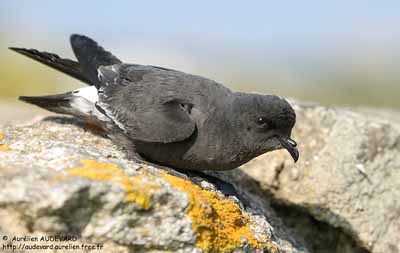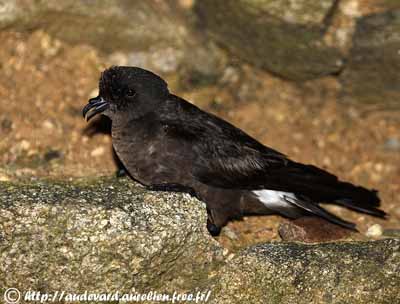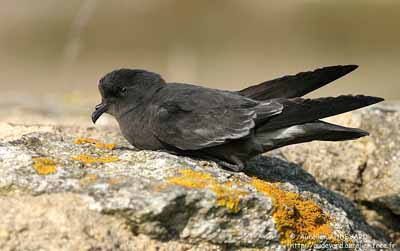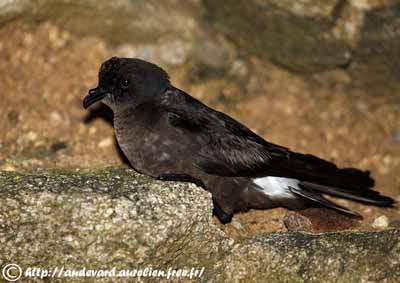
European Storm-petrel
Hydrobates pelagicus
Procellariiforme Order – Hydrobatidae Family
BIOMETRICS:
Length : 14-18 cm
Wingspan : 36-39 cm
Weight : 23-29 g
LONGEVITY: Up to 20 years
DESCRIPTION:
The European Storm-petrel often accompanies the sailors and follows the ships. It is the smallest of the European seabirds.

Adult has dark brown upperparts including wings and tail. The rump is white, and we can see a faint paler bar across the greater coverts.
Underparts are completely dark brown, excepted the white bar on the underwing.
Wings are short and rounded. Tail is rather squared.
Head is dark brown. The thin, hooked bill is black with tubular external nostrils on the upper mandible. Eyes are dark brown. Legs and feet are blackish.
Both sexes are similar.
Juvenile shows more conspicuous bar on the upperwing.
VOICE:SOUNDS BY XENO-CANTO
Storm-petrel is silent at sea, but at breeding colonies, it may utter an extended harsh purring “arrr-r-r-r-r-r-r…” in the burrow, ending with an abrupt “chikka”.
During the flight displays, it gives sharp “terr-CHICK”.
HABITAT:
Storm-petrel is usually kept away from land, except in breeding season. It is mainly marine and pelagic.
This species breeds on offshore islands and sometimes on promontories, on rocky or grassy areas.
RANGE:
Storm-petrel lives on North-east Atlantic, from Iceland, southwards along the western coasts of Europe and Africa, and also in Mediterranean from Spain to Greece, and probably Turkey.

BEHAVIOUR:
Storm-petrel feeds mainly on small fish, squid and crustaceans, and also offal. It feeds by fluttering flight, with hanging legs and the feet pattering on the surface. It may briefly alight for feeding. It follows the fishing boats for offal.
It is a migratory species, and it winters in South-Africa and Namibia. Some birds of the Mediterranean populations may remain near the breeding areas in winter, dispersing eastwards, sometimes until the Black Sea.
Storm-petrel is gregarious all year round, as at nesting colonies or at sea. They gather in small and loose groups when feeding, but large flocks may be seen at abundant food sources.
Storm-petrel is active by night, when adults return to the colony. They arrive after sunset but the peak of activity occurs in complete darkness. The nesters which have nesting duties spends the night at nest inside the burrow, and fly out at sea before dawn.
Storm-petrel ejects their stomach’s content in defence behaviour. It is an oily substance produced during the chick-rearing. But some predators such as falcons are able to capture them in flight, whereas skuas and owls catch then just as they emerge from the burrow.

Storm-petrel performs flight displays, engaging in aerial pursuits. Birds fly fast in circles above the nesting site, one bird following closely the other while they call loudly. At this moment, if the flight is performed in darkness, the white rump is very helpful for the birds.
Female is absent for two-three weeks before the egg-laying, in order to build up reserves to make the very large egg which is about 20-30% of her own body-weight. Male visits the nest hole at night during this period. This species produces only one brood per year.
FLIGHT:
Storm-petrel travels with fairly direct flight with almost continuous “bat-like” fluttering, interspersed with brief glides, twists and turns. It always flies close to the surface.
REPRODUCTION:
Breeding season varies according to the range.
Storm-petrel breeds in colonies in rock crevices or burrows. If the soil is soft, they may dig out the burrow with the bill and feet. They also may use abandoned burrows by other seabirds’ species or rabbits.
Usually, the tunnel may be up to three metres long, and the nest-chamber is at the end.

Female lays only one large white egg. Incubation lasts about 42 days by both parents. They take turns with stints of 4 to 7 days. At hatching, the chick is covered with pale grey down. Parents broods it the first week. It fledges about 64 to 73 days after hatching.
The chick is fed during the night with partly-digested substance of small fishes and crustaceans.
Then, the young bird flies out to the sea by night where it will probably live two to four years before to join a pre-breeder flock.
DIET:
Storm-petrel feeds mainly on zooplankton, crustaceans, squid and small fish. It also takes human refuse and offal.
PROTECTION / THREATS / STATUS:
Storm-petrel is widespread and the species is not globally threatened.
However, they suffer heavy predation by introduced mammals such as rats, cats, mice and mongooses, and also by Barn-Owls according to the range.
Fr: Océanite tempête
All : Sturmschwalbe
Esp: Paíño Europeo
Ital: Uccello delle tempeste europeo
Nd: Gewoon Stormvogeltje
Russe: Прямохвостая качурка
Sd: Stormsvala
Photographs by Aurélien Audevard
His website: OUESSANT DIGISCOPING
Text by Nicole Bouglouan
Sources :
HANDBOOK OF THE BIRDS OF THE WORLD vol 1 by Josep del Hoyo-Andrew Elliot-Jordi Sargatal - Lynx Edicions - ISBN: 8487334105
THE HANDBOOK OF BIRD IDENTIFICATION FOR EUROPE AND THE WESTERN PALEARCTIC by Mark Beaman, Steve Madge - C.Helm - ISBN: 0713639601
Wikipedia (Wikipedia, The Free Encyclopedia)